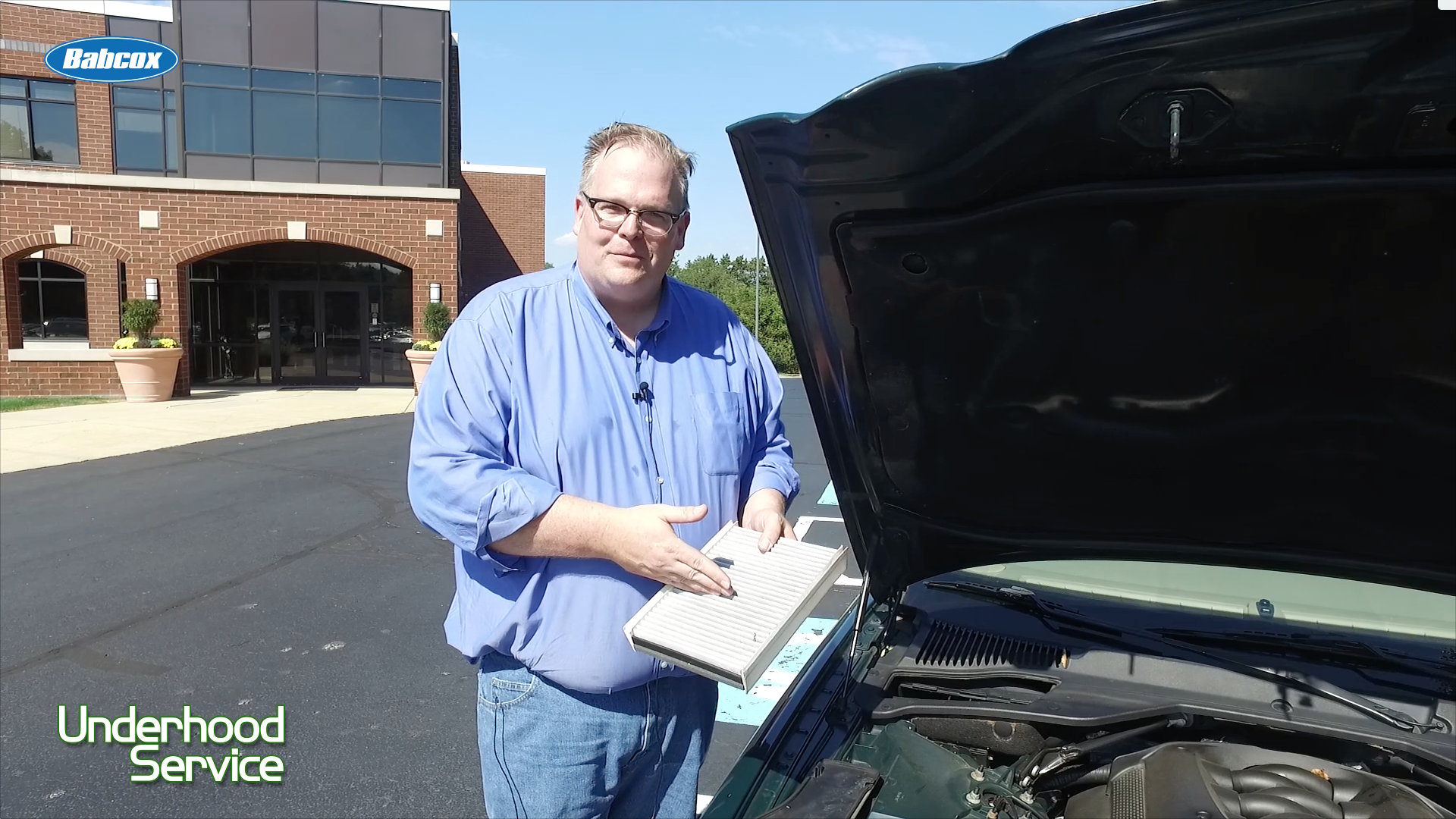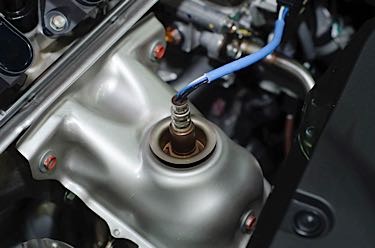MRSA. No, it’s not a new automotive acronym, and no it does not mean “mister service advisor.” You need to be aware of MRSA and what it means to everyone, especially people like us whose skin is frequently scratched and punctured on the job.
MRSA stands for Methicillin-Resistant Staphylococcus Aureus. This is a serious “super bug” that is everywhere. If your skin is broken, you can get it. This is the stuff that you hear about where someone gets a paper cut and three days later they are dead.
It kills people by getting into the blood. Once it is in the blood it is free to attack any organ. I’ve never been much of one to let a little skin being knocked off slow me down. A little blood dripping from that skinless knuckle? No big deal… just wrap a shop towel around it and go back to work… right? I’ve done that forever. Sometimes I come home with wounds that I didn’t even notice until they started to hurt a little. That is exactly what happened with my right forearm on a Friday night.
I didn’t notice it until I was getting into the shower. It was just a little scratch… one of those “Hmmm… looky there. How did I get that? Oh well, just another little scratch.” On Saturday, it started to hurt and looked a little red, but no more than they usually do. On Sunday it starting hurting and growing. The skin felt hot and hardened some.
I should have gone to the doctor then, but why do today what you can put off until tomorrow… besides… it’ll get better… they always do…. right? It was just a little scratch. But it did have me concerned enough to take a photo of it, especially when the skin came off of it and it oozed.
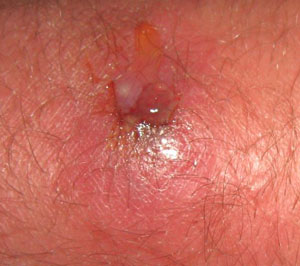
On Monday morning, it finally sunk in that I had a problem. This thing grew up in the middle of the night, was oozing and turned purple. My entire forearm was swollen from my elbow to my hand. And trust me, it was as painful as it looks in the first photo.
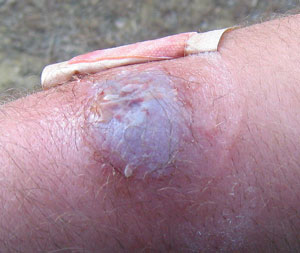
It was like a red hot fire poker being held in that spot. I went to the shop so show the boss, then go to the doctor. I grabbed this photo before walking into the doctor’s office. The doctor drained it, explained that it was a staph infection and prescribed some antibiotics for it. That seemed to help. It looked better, but was still draining a lot on its own. The draining was actually a good thing because that would get the infection out of my body.
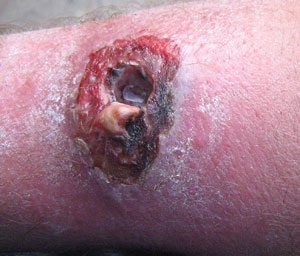
Tuesday evening, around 6 p.m. I found this when I pulled the gauze off. I found a hole in my arm that looked as if I got shot with a small caliber riffle. This hole is large enough in diameter to insert my pinky finger, and about 1/4 of an inch deep. That little “plug” of skin tissue, at the 6 o’clock position of the hole, was once inside that hole. It had turned into a rubber like consistency. It was not like flesh anymore. It was very much like a soft rubber plug.
The scariest part of all of this was the fact that I could not feel the wound anymore. The hole, and the blackened area around the hole, was completely without feeling. I had a dead spot in the middle of my arm. I also noticed a minor loss of feeling in my finger tips of that hand. I could still feel with them, but it felt like I had to feel through a thin “layer” almost. It has a slight “my arm is asleep” feeling.
So after seeing that, I figured it would be a good time to go to the emergency room. I headed to the emergency room at 5 p.m., and I didn’t get back home until 1 a.m. I got IV antibiotics pumped into me, X-rayed, drained and flushed for a few hours straight. They made me an appointment on Wednesday for a little outpatient surgery in a surgeon’s office. He took one look and said “Not here. We’re going to the hospital.” They knocked me out and carved a chunk out of my arm. I had to stay overnight and got home around 5 p.m. Thursday with this vacuum pump on my arm that instantly removes any ooze and contains it. The hose coming off of this thing is about the size of a fuel line.
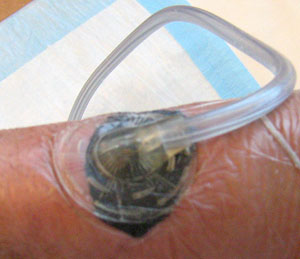
Can you imagine trying to work with this on your arm? How about reaching into tight places? Not going to happen is it. The black you see under the suction cup is a foam packing that goes down into the wound area. So, I leave work on one Friday night saying “See ya Monday!”, but instead I stop by a week later to pick up my paycheck and show off my arm and tell the story.
The surgeon says I should stay out of work for a month. I can function, but what will that be like as a technician with a wound this deep? How am I supposed to reach into places with a hose the size of a fuel line stuck to me?
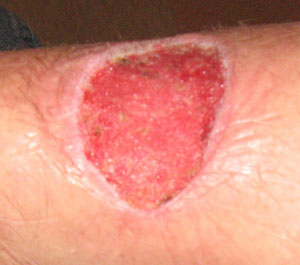
Gauze might keep it clean from the grease and dirt, but what about gasoline? Brake fluid? Antifreeze? What about reaching into tight areas where my arm usually barely fits without a ball of gauze on my forearm? Obviously, the repercussions from this are not over for me for a few months. I might go back to work in a few weeks, but this will lower my output for a while.
The point of this story is to not brush off those day-to-day scratches we get. Use the shop’s first aid kit or keep your own at your tool box. If you get an open wound, treat it right away with something better than a shop towel. Do it right. Use something like hydrogen peroxide or iodine on it to disinfect it. You probably have staph bacteria on you right now. It is usually found on the skin and nasal passages of about one out of three people.
Outside of the body, it is fairly harmless and lives there undetected. But, the one person who has it can pass it to someone else with direct or indirect contact. Let’s say there are three techs in a shop, one of them has staph germs on his hand and grabs a door knob. Then the other two techs use that same door knob. If either of those techs scrapes a hand afterward, before they can wash, they may have happen to them what happened to me. Can you imagine getting something like this on your face? In your ear? Neck?
I’ve always been one to wash between every job so as to not nasty up the car. I always wash to, and sometimes past, my elbows while on the job. Sometimes, I’ll stop on a very nasty job just to wash some of it off, knowing I’m going to get more on me. So lack of washing was not a problem. Apparently, the bacteria was able to get rooted in before the hand cleaner and water came along. I should have treated it with peroxide the second it happened, but I hadn’t noticed it until later.
Since the accident was not reported the minute it happened, it is not covered by a worker’s compensation. From the time it was noticed on Friday night to Monday morning I could not report it. I didn’t think about where I likely got it from until I was sitting in that hospital room on Thursday looking at the hunk of meat gone from my arm.
Even if I had realized that little scratch happened when it did, I’d probably not have bothered the management over it. I mean, come on, was I really going to go hoo-hooing to the boss over a little scratch? It was just a little a scratch…. right?









